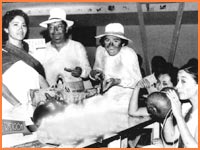In some of the central to northern regions the popular Norteña and Mexican rodeo influences are very present, whereas in the coastal or southern regions, Carnivals represent a more indigenous rendition. Each one will include many region-specific food dishes and drinks.
|
Cozumel's Carnival is thought to be the oldest in the Yucatan Peninsula and possibly in the whole of Mexico.
In 1876, La Revista de Merida magazine, first recorded the event. |
According to word-of-mouth, in 1896 costume competitions and ribbon dancing were organized during Carnival and a wooden bull called Huacax-xhé was made.
In 1904, for the first time, Don Manuel Vivas Martín, together with a baker from Campeche, introduced the Guaranducha to the Carnival. This traditional musical performance is thought to be from Cuba originally, but was made popular in Campeche.
|
In this musical play, the heros are played by blacks, and although all the parts are all female, all the actors are male.
Just before the 1920s, Félix González Bonastre arrived to the island from Tabasco and became involved in the event. |

Generations of fun.
|
He helped with the organization of student music groups, songs and social reviews for the Guaranducha.
From then on, the Guaranducha was enthusiastically supported by carnaveleros and finally, in the 1940s, women were also able to take part for the first time.
Like the island's economy, Cozumel's Carnival went through the doldrums in the early 1970s. It was rescued again by the Municipal Government in 1975, when the fiesta received a new impetus and regained popularity with locals.
Today, the tradition strengthens every year, as this safe, popular, family celebration continues to grow. The glamor and happiness that new generations have inherited help to ensure that Cozumel's Carnival will always be the best in the state.

Hola, me llamo Maria, Felix Gonzalez Bonastre era mi bisabuelo y quería saber si me podía mandar esa foto ya que en la pagina sale muy chica. También me gustaría preguntarle si sabe usted quienes son los demás de la foto? Mi familia y yo se lo agradeceríamos mucho. Saludos
ReplyDelete